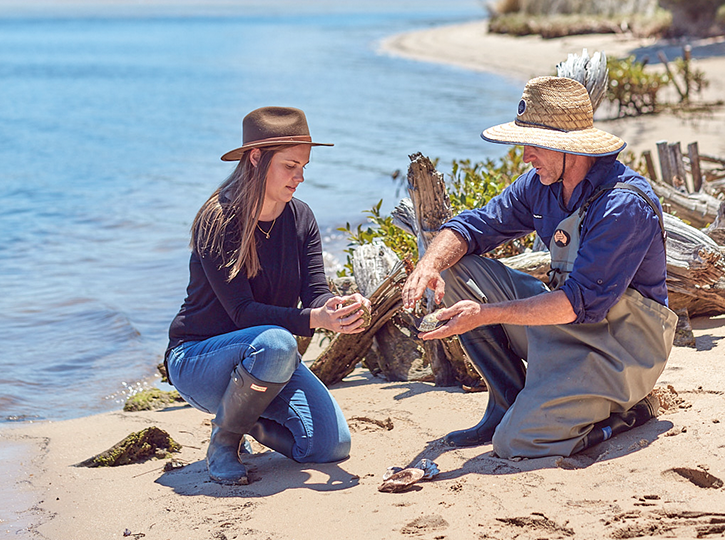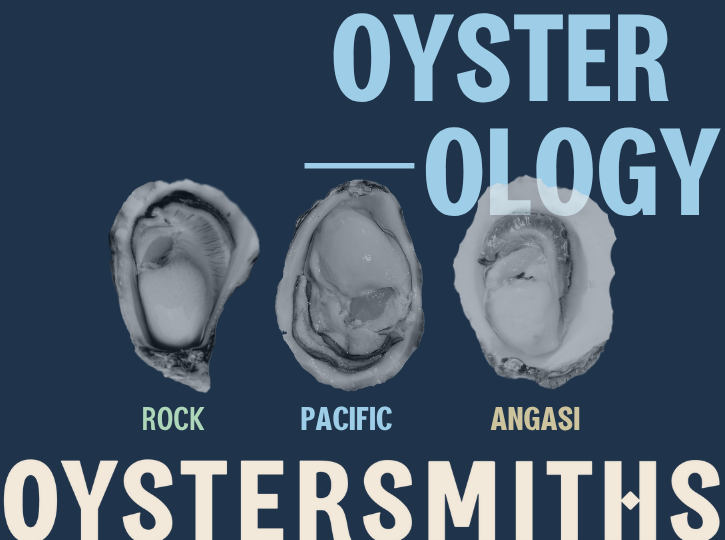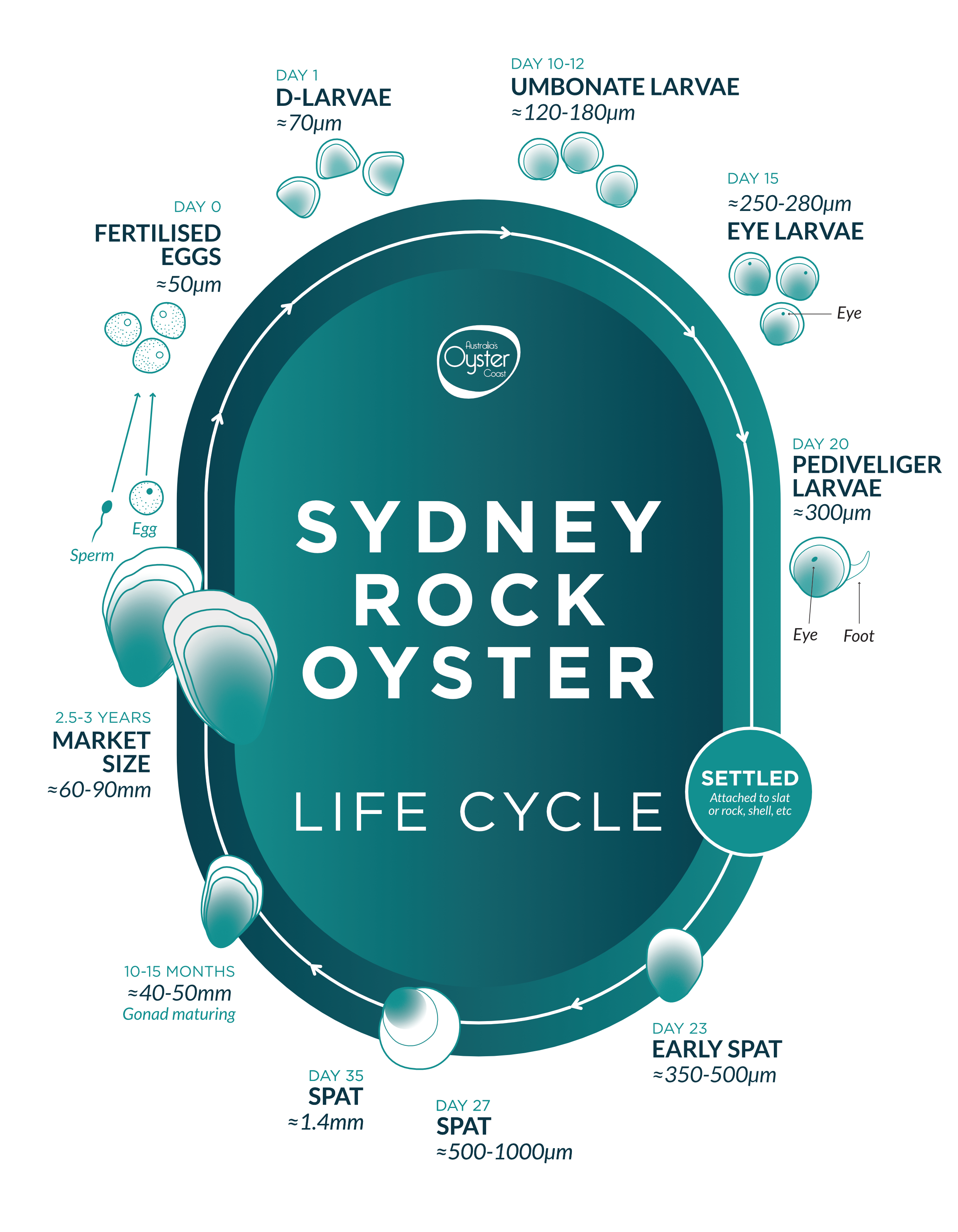Oysterology 101

Oysterology 101: The Study of All Things Oysters
Oysterology refers to the study and appreciation of oysters, from the different species, how they grow, clean our oceans and keep us healthy, to why they taste different depending on where they come from. Consider this your crash course in everything oysters - with flavour, science, and sustainability in the mix.

Let’s Talk Biology
Oysters are bivalve molluscs, meaning they have two shells hinged together. But there’s more going on than meets the eye. These creatures start life as tiny, free-floating larvae and go through a fascinating transformation as they grow. Many species, including Australia’s iconic Sydney Rock Oysters, begin life as males and later change to females - a process called sequential hermaphroditism. It’s nature doing its thing, oyster-style. For more information, refer to the Sydney Rock Oyster Life Cycle below.
In Australia, we farm three species:
Sydney Rock Oysters (Saccostrea glomerata)
The Rock Oyster is native to the east coast of Australia and is farmed from Southern Queensland to the Southern border of New South Wales, these oysters are grown in rivers, lakes, and bays under estuary specific Environmental Management Systems. The Rock Oyster takes at least 3 years to grow ready for harvest.
Pacific Oysters (Crassostrea gigas)
The fast-growing Pacific Oyster was introduced to Australian waters for aquaculture back in the 1940’s. A world-wide favourite, Pacific oysters are grown under carefully managed environmental conditions from regulated oyster growing estuaries in New South Wales, Tasmania and South Australia.
Angasi Oysters (Ostrea angasi)
The Angasi Oyster is a rare native oyster grown predominantly in estuaries in Tasmania and southern New South Wales.
Each oyster has its own unique flavour, texture, and growth habits - kind of like oyster personalities.

Oysters and the Ecosystem
Oysters don’t just live in the water - they clean it. As filter feeders, oysters draw in water to consume microscopic algae, removing excess nutrients and helping balance the estuarine ecosystem. A single oyster can filter up to 100 litres of water per day. Multiply that by a whole farm and you’ve got a powerful natural filtration system.
Oyster reefs also create essential habitat for other marine life like fish, crabs, seahorses and more. That means when you support oyster farming, you’re supporting biodiversity and cleaner oceans.
Culinary Culture
Oysters have been celebrated in cuisine for centuries, and for good reason. They’re rich in flavour, brimming with nutrients, and offer a special culinary experience. Whether you enjoy them raw with a squeeze of lemon, grilled with miso butter, or dressed in citrusy gin granita (hello, summer!), oysters are a seasonal delicacy that invite slow appreciation.
At Oystersmiths, we celebrate the diversity of flavour that comes from “merroir”- the marine equivalent of terroir. Just like wine reflects the place it’s grown, oysters carry the signature of their estuary, influenced by tides, temperature, seagrasses, water salinity, and seasonal conditions. Each estuary = a different flavour profile.
The Craft of Oyster Farming
Oyster aquaculture is one of the most sustainable forms of food production on the planet. It requires no feed, no fertilisers, and no chemicals. At Oystersmiths, we farm ourselves and also partner with expert farmers from some of Australia’s most pristine coastal waters.
It can take up to 3 years for a Rock Oyster to be ready. So, yeah, there’s a whole lotta care, patience, and farming wisdom behind every shell.
Conservation & Climate
Oysters may be resilient, but climate change is creating real and growing challenges for Australia’s oyster industry.
Rising water temperatures, increased ocean acidification, shifts in salinity, and more frequent extreme weather events are all placing pressure on estuarine environments. These changes can affect oyster health and productivity and lead to increased risk of disease, disrupted growth patterns, and in some cases, large-scale mortality events.
But there’s hope. Around the world, and here in Australia, oyster restoration and research projects are helping us understand how to adapt. From developing more resilient oyster lines to restoring natural reefs and improving waterway health, the oyster industry is stepping up and working hard to protect our livelihoods and the health of our coastal environments.
Choosing sustainably farmed oysters helps support this important work and ensures future generations can enjoy clean waterways and thriving oyster ecosystems.
Oysterology in Action
Whether you're here for the flavour, the marine science, or the salty aesthetic, there’s more to oysters than meets the eye. At Oystersmiths, we don’t just sell oysters - we live and breathe them and then carefully curate them for your enjoyment and culinary curiosity. From understanding their flavour profiles to supporting the ecosystems they grow in, oysterology is part of everything we do. It’s science, sustainability and salty deliciousness, all rolled into one shell.
Curious to learn more or taste the difference for yourself? Follow our Instagram page and join the salty side – we’ve got plenty more oyster facts, recipes, and farm stories to share.
